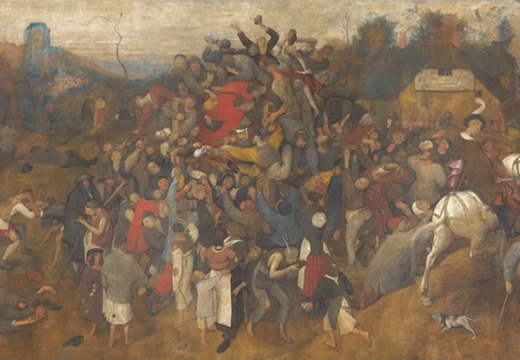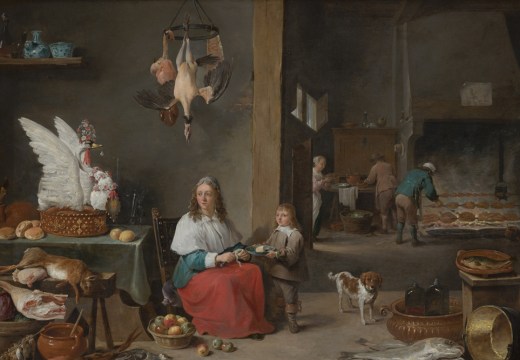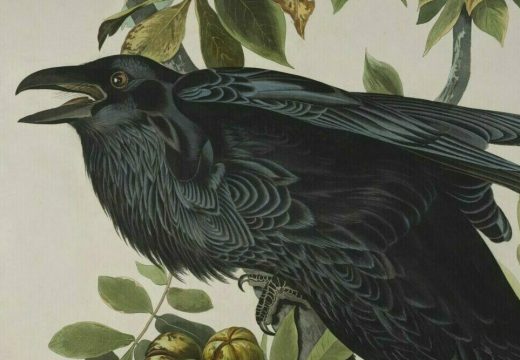From the December 2023 issue of Apollo. Preview and subscribe here.
There is an evocative, windy watercolour in the Tate’s collections, described as An Upland Valley, with a Woman Driving Geese by J.M.W. Turner, and dated around 1816. It shows a tiny parade of life on an expanse of khaki fell, the angular necks of the white geese echoed by the shapes of clouds above what might be Wharfedale or Ilkley Moor. Both are near Farnley Hall, just outside Otley in Yorkshire, where Turner enjoyed long stays with his friend and patron Walter Fawkes from 1808–24.
Turner was exhilarated by the skies, moors and bird life (including grouse shoots) of his Yorkshire quarters; treasured the pleasures of family life, friendship and the excellent ‘culinary exploits’ of the Fawkes’s cook, Hannah. After the death of Walter Fawkes in 1825, his family continued to send Turner gifts of game, or often a Yorkshire pie or goose pie for Christmas. ‘Mother Goose came […] before Christmas day […] The pie is in most excellent taste,’ he wrote in thanks in 1849.
Goose pie was the north’s Christmas speciality. The social reformer Frederick Morton Eden noticed how, in Cumbria, ‘The crust of the goose-pye, a dish with which almost every table in the county at that season is supplied, was made of barley-meal.’ (Though he regrets that the wheat habit was spreading.) York- shire, of course, had to go one better with a ‘Yorkshire Pie’ – a boned turkey, goose, fowl, partridge and pigeon, stuffed inside each other like Russian dolls. Hannah Glasse, herself brought up in Northumberland, gave a recipe in her famous cookbook, The Art of Cookery Made Plain and Easy (1747), and mentioned that ‘these pies are often sent to London in a Box as presents’. The Fawkes family did just this in 1845 and Turner wrote a nostalgic thank you letter praising it as ‘equal good to the Olden-time of Hannah’s’.
Goose was a once-a-year treat for many; but those with a little more wealth might enjoy a young ‘green goose’ in the summer, with gooseberries or lemony sorrel to cut through the fat. Apple sauce sharpened up the Michaelmas goose which, fattened by gleaning on the stubble after harvest, was supposed to bring luck. ‘I dined upon goose yesterday, which, I hope, will secure a good sale of my second edition’; Jane Austen joked in a letter to her sister Cassandra on 11 October 1813. Roast goose was the Christmas meat for families of all walks of life. Even quite poor people might keep a goose or two on the local common. The radical writer and politician, William Cobbett, guessed there were 10,000 geese on just six miles of the commons in Surrey. Huge, noisy flocks were driven from East Anglia to markets and fairs in London and other cities. Cobbett advised cottagers to buy geese from the common and fatten them up on oats and a parcel of lettuces from the garden two or three times a day. Other farm- ing writers advised the opposite – geese were profitable where there was a good common and river to keep them.
As England became more urbanised, the Michaelmas goose migrated to Christmas and the urban poor paid into ‘goose clubs’, often run by publicans, to guarantee a magnificent roast dinner. In A Christmas Carol (1843) by Charles Dickens, the Cratchit children inhale the smell of all the geese being roasted by the local bakery, for families without an unaffordable oven, convinced they can smell their own, ‘and basking in luxurious thoughts of sage and onion’ (reliable winter staples). This, of course, is before the reformed Scrooge turns up on Christmas day with a more luxurious turkey (which Mrs Cratchit is expected to cook… how?). Mrs Beeton priced a goose for ‘8 or 9 persons’ at 5s 6d in 1861. The smaller (in those days) turkey might cost twice as much – and more over Christmas.
Goose fat has recently been talent-spotted for its low melting point and high smoking point, by chefs looking for the perfect roast potato. Today we are more likely to encounter a jar of goose fat in the supermarkets than the bird itself. Its juicy flesh and the bountiful fat, which seems to pour off it by the bucketload in the oven, have become a taste for the wealthy. It wasn’t just Scrooge and his symbolic turkey which spelled the end of the Christmas goose. Geese were creatures of the common, and most commons were hedged and fenced off for more lucrative cattle and sheep farming. Over 5,200 Acts of Inclosure (later ‘Enclosure’) transformed 6.8m acres of land in England and Wales. There are still some upland commons used by farmers in Yorkshire and elsewhere, particularly in National Parks, for sheep grazing. If you visit Turner’s Upland Valley today, you will see sheep and walkers, but the 12 geese which you can (almost) hear honking loudly in his painting have disappeared.
From the December 2023 issue of Apollo. Preview and subscribe here.
Unlimited access from just $16 every 3 months
Subscribe to get unlimited and exclusive access to the top art stories, interviews and exhibition reviews.














![Masterpiece [Re]discovery 2022. Photo: Ben Fisher Photography, courtesy of Masterpiece London](http://www.apollo-magazine.com/wp-content/uploads/2022/07/MPL2022_4263.jpg)
It’s time for the government of London to return to its rightful home